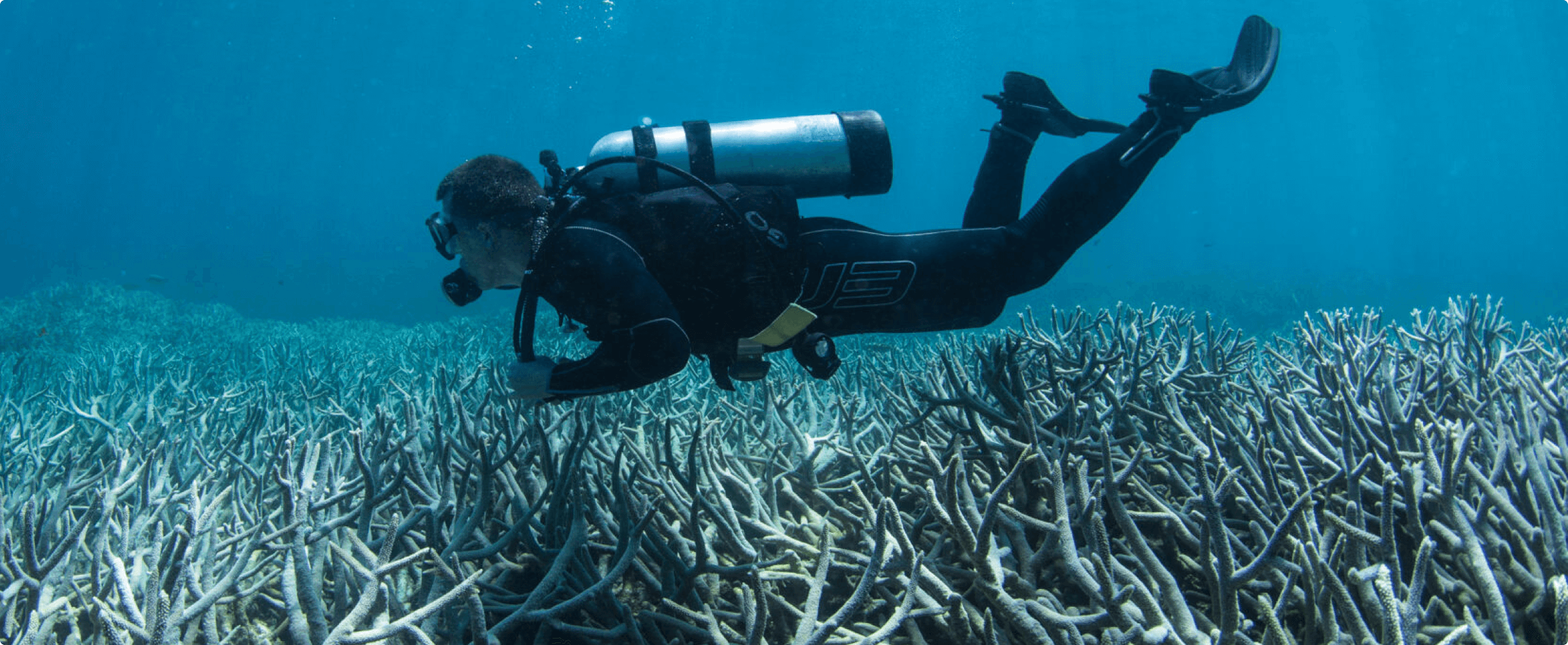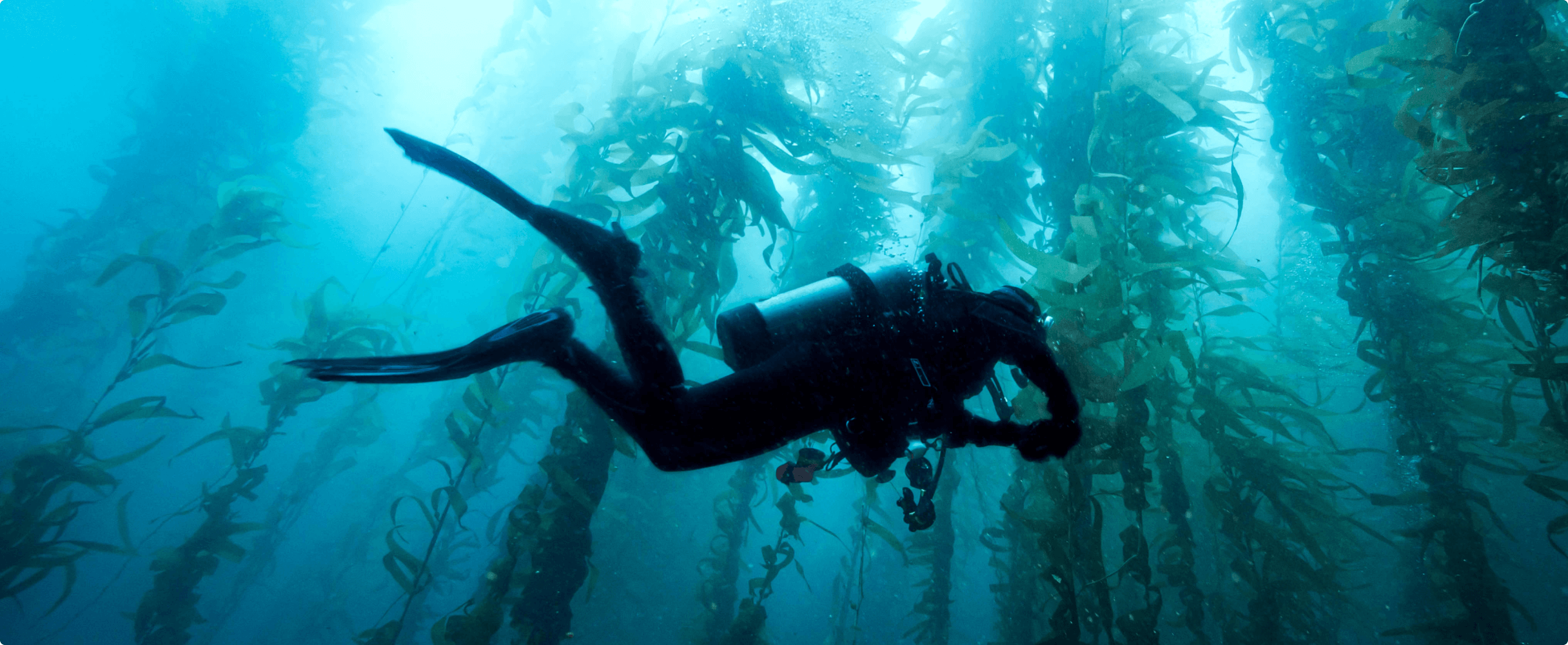Our Strategy
The biggest threat to the ocean is the enormous quantity of excess greenhouse gases built up in our atmosphere. This drives two dangerous changes:
Heating
Carbon dioxide traps excess solar energy, 90% of which is absorbed into the ocean
Acidification
Excess CO2 created since the Industrial Revolution has ended up directly in the ocean, resulting in a 30 percent increase in ocean acidity.

These thermal and chemical stresses outweigh in impact and risk everything else that we are doing to the ocean. These stresses are driving deoxygenation, marine heat waves and coral bleaching, increased stratification, and much more.
Unfortunately, these two stresses will only grow and intensify as atmospheric concentrations of greenhouse gases continue to increase.
Ocean Visions’ four-part agenda focuses on directly addressing the causes and impacts of this climate disruption.

The ocean offers numerous pathways for decreasing societal emissions of carbon dioxide.
These pathways include, but are not limited to:
- Ocean-based renewable energy, including offshore wind, tidal and wave energy, and ocean thermal energy conversion
- Expanded supply of low carbon ocean-based sources of food
- Production of ocean-based feedstocks for industrial materials and processes
- Low-carbon shipping
Our Strategy
Ocean Visions conducted an in-depth analysis to identify high-leverage, underinvested opportunities where we are uniquely positioned to contribute to the advancement of ocean-based pathways that avoid emissions of carbon dioxide. We are now expanding our accelerator program, Launchpad, to include early-stage companies working on marine renewable energy and conducting a road mapping process to examine the full potential for marine algal biomass to contribute to decarbonization along the entire value chain.

In addition to the need for reducing and eventually eliminating greenhouse gas emissions, the Intergovernmental Panel on Climate Change has made clear that large-scale carbon dioxide removal (CDR) is part of every viable scenario to hold temperatures to a 1.5°C increase—the goal set out in the Paris Agreement.
As the largest carbon reservoir on the planet, the ocean holds enormous potential to safely draw down and sequester additional carbon dioxide.
Our Strategy
To chart the way forward to research and develop these technologies, Ocean Visions, with experts from around the globe, developed a series of road maps that assess the developmental stage of various technologies and identify the obstacles and first-order priorities to advance responsible R&D. Our work is now focused on catalyzing broad-based effort against these priorities:
- Provide actionable and current information through maintenance and further development of our ocean-based CDR road maps.
- Catalyze action and investment against the biggest priorities by co-designing research agendas, mobilizing resources, and leading on key activities.
- Provide technical assistance and expert evaluation to innovators and start-ups that have potentially scalable innovations.
- Create a more favorable enabling environment for accelerated research and development by building enabling policy, governance, and economic frameworks.

Increased ocean temperatures and changing chemistry have triggered a host of consequences for marine ecosystems, from widespread coral reef damage, oxygen-deficient “dead zones”, and—perhaps most seriously—a diminishing cryosphere, which plays a pivotal role in climate regulation.
The best current science on these key tipping points establishes the risk that neither decarbonization nor negative emissions, alone or combined, will cool the planet in time to prevent state shifts in critical ecosystems and functions.
Our Strategy
Given the enormity of the risk, Ocean Visions is researching pathways that may be able to forestall passing tipping points:
- In 2023 Ocean Visions launched a new program to systematically identify and assess a full range of potential ideas to prolong and reinforce the function of critical components of the ocean-climate system. The first ecosystem Ocean Visions is focusing on is Arctic sea ice, which is a critical component of the global climate system because of its contribution to the Earth’s reflectivity (albedo) and potential to influence global weather patterns. In addition, the Arctic environment is already warming up more quickly than the rest of the world.
- Ocean Visions developed a digital, interactive road map assessing tools and strategies that may be able to slow the loss of and rebuild Arctic sea ice. Ocean Visions is now working to mobilize action on a subset of the first-order priorities identified in the road map.

Essential to generating and scaling solutions to the ocean-climate crisis is the need to expand the global community of people and institutions working together to develop, test and adapt solutions to different circumstances.
Our Strategy
In order to expand the community of “solvers” at the ocean-climate nexus, Ocean Visions is executing initiatives to broaden and deepen diverse engagement around the globe:
- Endorsed by the United Nations Decade of Ocean Science for Sustainable Development, Ocean Visions’ Global Ecosystem for Ocean Solutions (GEOS) program aims to accelerate collaboration across diverse sectors and geographies, fostering a globally distributed community dedicated to delivering innovative, effective, and durable solutions to the ocean-climate crisis.
- Ocean Visions strives to expand the global dialogue around ocean-climate solutions and ignite a broader community around a new agenda by engaging in various domestic and international gatherings and through its Biennial Summit.